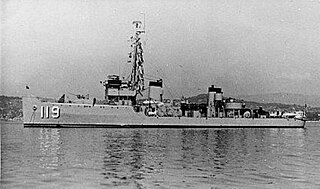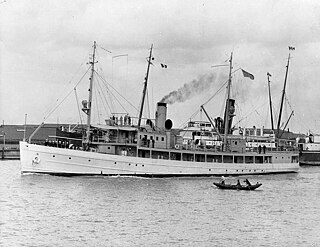
The third USS Perry (DD-340/DMS-17) was a Clemson-class destroyer in the United States Navy following World War I. She was one of eight ships named for Oliver Hazard Perry.

USS Millicoma (AO-73) was a United States Navy fleet oiler which served in the Pacific Theatre during World War II, winning eight battle stars for her dangerous work. Post-war she was recommissioned and was placed under the control of the MSTS with a civilian crew until finally assigned for disposal in 1987.

USS Seer (AM-112/MSF-112/MMC-5) was an Auk-class minesweeper of the United States Navy that served during World War II and the Korean War, and was sold to Norway in 1962.
USS Symbol (AM-123) was an Auk-class minesweeper acquired by the United States Navy for the dangerous task of removing mines from minefields laid in the water to prevent ships from passing.
USS Sage (AM-111) was an Auk-class minesweeper acquired by the United States Navy for the dangerous task of removing naval mines.

USS Speed (AM-116) was an Auk-class minesweeper acquired by the United States Navy for the dangerous task of removing mines from minefields laid in the water to prevent ships from passing.

USS Steady (AM-118) was an Auk-class minesweeper acquired by the United States Navy for the dangerous task of removing mines from minefields laid in the water to prevent ships from passing.

USS Sustain (AM-119) was an Auk-class minesweeper acquired by the United States Navy for the dangerous task of removing mines from minefields laid in the water to prevent ships from passing.

USS Penguin (AM-33) was a Lapwing-class minesweeper acquired by the United States Navy, named after the bird.

USS Rail (AM-26/AT-139/ATO-139) was a Lapwing-class minesweeper built for the United States Navy during World War I. She was the first U.S. Navy ship named for the rail, a small wading bird, related to the cranes.

The second USS Planter (ACM-2) was a Chimo-class minelayer in the United States Navy during World War II.
USS Cardinal was a YMS-1-class minesweeper of the YMS-135 subclass built for the United States Navy during World War II. She was the third ship in the U.S. Navy to be named for the cardinal.
USS Implicit (AM-246) was an Admirable-class minesweeper built for the U.S. Navy during World War II. She was built to clear minefields in offshore waters, and served the Navy in the North Atlantic Ocean and then in the Pacific Ocean. She finished the war with two battle stars to her credit.
USS Improve (AM-247) was an Admirable-class minesweeper built for the U.S. Navy during World War II. She was built to clear minefields in offshore waters, and served the Navy in the North Atlantic Ocean and then in the Pacific Ocean. Improve received two battle stars for World War II service.
USS Incessant (AM-248) was an Admirable-class minesweeper built for the U.S. Navy during World War II. She was built to clear minefields in offshore waters, and served the Navy in the North Atlantic Ocean and then in the Pacific Ocean. She returned home at war's end with two battle stars to her credit.
USS Mainstay (AM-261) was an Admirable-class minesweeper built for the U.S. Navy during World War II. She was built to clear minefields in offshore waters, and served the Navy in the Atlantic Ocean and the Pacific Ocean.
USS Rebel (AM-284) was an Admirable-class minesweeper built for the United States Navy during World War II. She was awarded four battle stars for service in the Pacific during World War II. She was decommissioned in June 1946 and placed in reserve. While she remained in reserve, Rebel was reclassified as MSF-284 in February 1955 but never reactivated. In October 1962, she was sold to the Mexican Navy and renamed ARM DM-14. In 1994 she was renamed ARM Cadete Fernando Montes de Oca (C57). She was stricken in July 2001, but her ultimate fate is not reported in secondary sources.
USS Reform (AM-286) was an Admirable-class minesweeper built for the U.S. Navy during World War II. She was built to clear minefields in offshore waters, and served the Navy in the Pacific Ocean before voyaging to the U.S. East Coast for decommissioning. Post-war, her crew returned home with three battle stars to their credit. The ship itself, its wartime mission complete, was given to China.
USS Gavia (AM-363) was an Admirable-class minesweeper built for the United States Navy during World War II. The ship was ordered and laid down as PCE-905-class patrol craft USS PCE-907 but was renamed and reclassified before her September 1943 launch as Gavia (AM-363). She earned two battle stars in service in the Pacific during World War II. In May 1946, she was turned over to the Republic of China for service with the Chinese Maritime Customs Service as Yung Chun. She was removed from service in June 1962.

USS Reedbird (AMS-51/YMS-291) was a YMS-1-class minesweeper of the YMS-135 subclass acquired by the U.S. Navy for the dangerous task of removal of mines that had been placed in coastal waters to prevent ships from passing.









